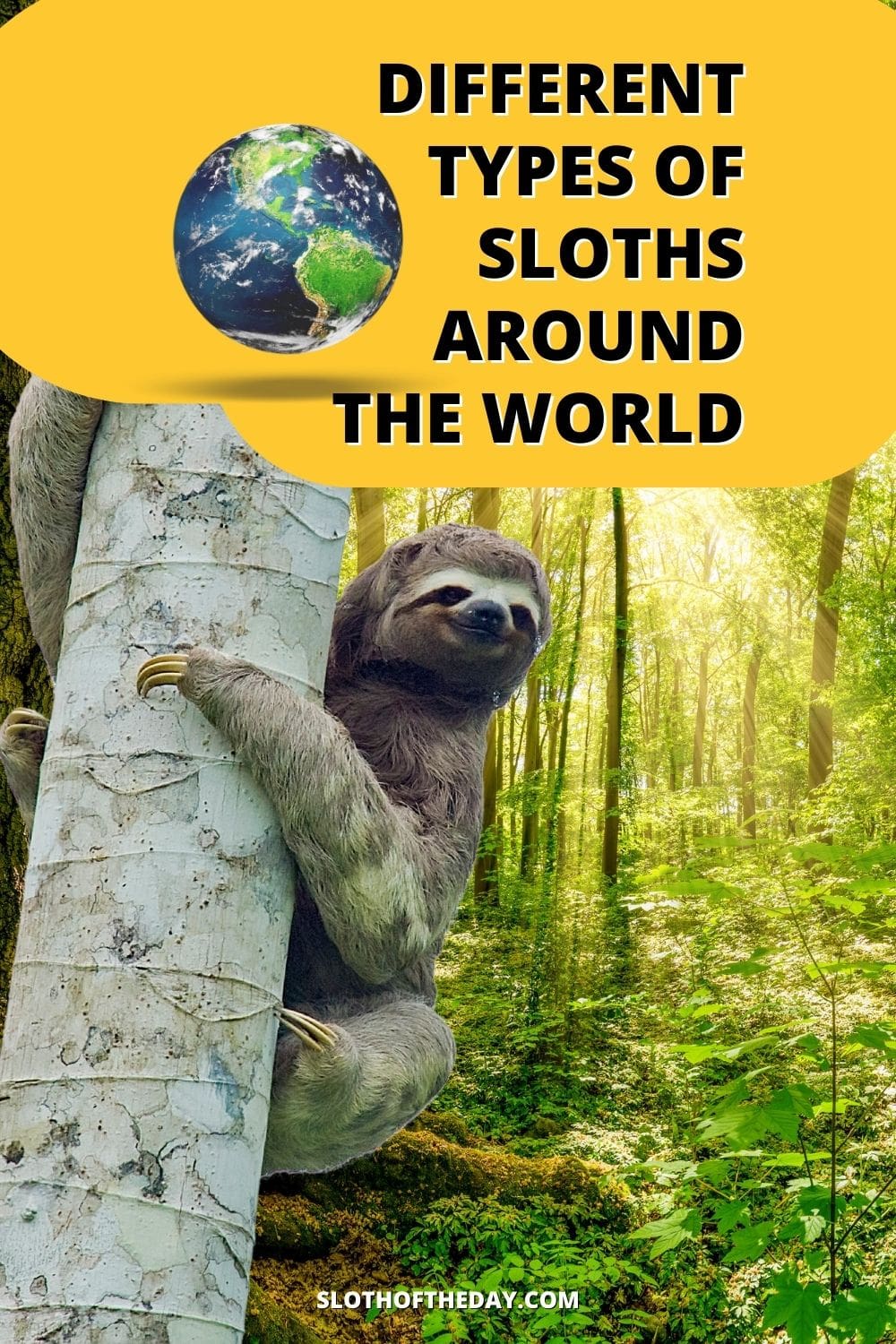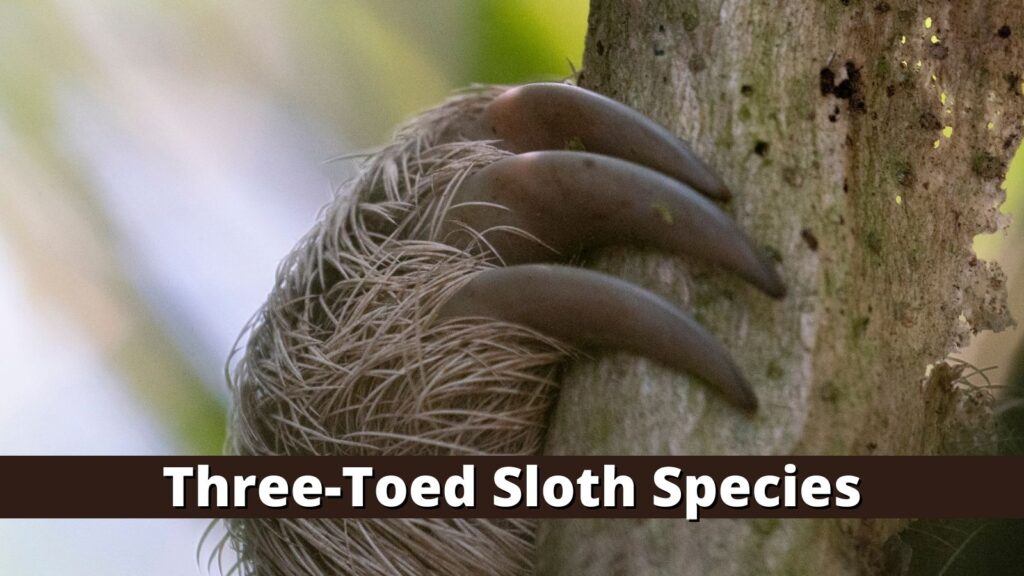Table of Contents
Types of Sloths Around The World. Types, species, subspecies, order, and other categories of sloths. It can be confusing. How do we classify our sloth friends?
In this type of sloths article, we will be discussing…
- Different Types of Sloths Around The World
- How Many Kinds of Sloths Are There?
- What Are The Different Types of Sloths?
- Meaning of Sloth Words
- How Do You Tell the Species Apart?
- Two-Toed Sloth Species
- Where Can You Find Two-Toed Sloths?
- Linnaeus and Hoffman Sloths Differences
- Three-Toed Sloth Species
- Where to Find Three-Toed Sloths
- Three-Toed Sloths Details
- Sloth Genealogy
- Recent Sloth Fossils
- What About Our Modern Sloths?
- Two-Toed Sloth and Three-Toed Sloth Ancestors
- The Mylodon Two-Toed Sloth Ancestor
- The Megalonyx Ground Sloth
- The Megatherium Ground Sloth
- Why Are Sloths So Small, Now?
- Who Else is Related to the Sloth?
Most people do not know the different types of sloths that there are. Read below for all types of sloths’ details.
Different Types of Sloths Around The World

If you’ve wondered about how many there are and if they’re all related, here’s a quick overview of some very basic classifications and descriptions.
Don’t worry, we’ll try to make it simple and interesting. So, come along and climb the sloth’s family tree.
How Many Kinds of Sloths Are There?
The question came up at sloth of the day recently of how many kinds of sloths there were.
Some people say that there are two, others that there are four, still, others say six and some even say seven.
So, we decided to see if we could find out… What type of animal is a sloth?
At its most basic, there are two types of sloths around the world based on how many toes they have: two-toed and three-toed sloths.
But, within those two are species. There are four species of a three-toed sloth and two species of two-toed sloth.
That makes a total of six sloth species. Those saying there are two kinds of sloths may be looking at the two types of sloths or the two species of a two-toed sloth.
Those saying there are four kinds may only be looking at the four species of the three-toed sloth.
Six would cover all the species in both types of sloths. What about a seventh? I looked it up online, googling seven species of sloth and what came up were listings for the giant ground sloth, so some may be counting that as a seventh species.
We’ll look a little at all of these below.
- Where Can I Find a Sloth? We have a post that lists about 40 states in America where you are able to find a sloth.
What Are The Different Types of Sloths?
Here are the different types of sloths and species for a quick reference.
Three-Toed Sloths Species
- Brown-Throated Sloth (Bradypus Variegatus)
- Pale-Throated Sloth (Bradypus Tridactylus)
- Maned Sloth (Bradypus Torquatus)
- Pygmy Sloth (Bradypus pygmaeus)
Two-toed Sloths Species
- Linnaeus’s 2-Toed Sloth (Choloepus Didactylus)
- Hoffman’s 2-Toed Sloth (Choloepus Hoffmanni)
Now, these guys are part of a taxonomic order and suborder. Taxonomic only means a way of classifying something.
Sloths are part of the order Pilosa and the suborder Folivora.
The anteater, a relative of the sloth, as is the armadillo, is the only other animal in this order.
Now all these big words only served to confuse me. So, I looked them up.
These are just words in a language that isn’t spoken much anymore.
But I guess they sound more sophisticated and learned than if they just called the animals what those words mean in English. Wanna see?
Let’s take Pilosa. It’s Latin for hairy. and Folivora is Latin for a leaf eater. So their order is leaf eater, suborder hairy.
Making a presentation to a learned group of academics on hairy leaf eaters doesn’t have quite the sophistication or ability to impress they were looking for so they went with the Latin.
Meaning of Sloth Words
To make it easier to understand we added the meaning of some of the words below.
- Bradypus is Greek for slow feet.
- Choloepus is Greek for lame footed.
- Didactylus is Greek for two-toed.
- Tridactylus is Greek for three-toed.
- Variegatus is Greek for different colors or variegated.
- Torquatus is Roman for wearing a necklace, collar or the type of collar worn in Roman times called a torque.
- Pygmaeus is Greek for a dwarf.
That means you’ve got a different colored slow foot, a three-toed slow foot, a slow foot wearing a necklace, and a dwarf slow foot. Plus, you have a two-toed lame foot and a Hoffman’s lame foot.
The proper names used in the two-toed sloth designations are after two scientists, Karl Hoffman who was a naturalist in Germany, and Carl Linnaeus who was a botanist in Sweden.
This explains how the sloths came to be named.
How Do You Tell the Species Apart?
The species within each type have several characteristics in common with one another and some that are unique to that species.
In an effort to make it simple, we’ll look at what they have in common first and then talk about the differences.
Then you can know the names of your favorite types of sloths and species.
Two-Toed Sloth Species

Let’s start with two-toed sloths. The obvious thing they have in common is the fact that they have two toes on their front legs. The bottoms of their feet are padded and tough.
Neither has a tail. They both live in trees and spend most of their lives upside down.
Algae grow on their fur since they’re so slow it doesn’t blow or brush off.
The green of the algae makes them blend into trees so predators don’t notice them.
The hair grows from the middle part down the length of the stomach and hangs down the sides so water can flow off.
It also keeps them warm. Their usual body temperature is between 75 and 92 degrees F. And yeah, all the species of both types are slow.
The fact that they barely move also makes them blend with the trees.
They both come down to poop at the base of the tree about once a week.
Active at Night and Sleep
They are most active at night and sleep more in the daytime.
Two-toed sloths are about 21″ to 27″ long and weigh an average of 12 lbs. Not too heavy to hold, huh?
There are about 7 vertebrae in their necks and gives them the ability to hold their head straight or in the direction they’re looking while upside down.
Neither have enamel on their teeth. Meals are usually leaves and fruit and occasionally a bug or small animal.
Their stomachs have four chambers or sections, much like a cow’s stomach. Food takes a little over two days to digest.
Since it’s too difficult to get to a stream for water, they just get their water from the food they eat.
Both species become sexually mature at about three years old for females and 4 years old for males.
The males don’t help raise the babies at all. They mate in the rainy season and give birth right before the dry season begins and only have one baby at a time, usually.
The male secretes something onto a branch to let her know he’s around and she will all-out scream to get his attention when she’s in heat.
I’d prefer flowers and a phone call but that’s just me. Otherwise, when they aren’t starting a family, they like to live alone.
Where Can You Find Two-Toed Sloths?
You can find them both in high altitudes, in rainforests, and sometimes in lower areas throughout Central and South America.
Two-toed sloths live fairly well in captivity and are the ones you’ll most likely see in a zoo.
There are many places in America and other parts of the world where you can also see a sloth in Zoos and Habitats.
Check out our post for 40 States To See a Sloth in The United States.
Linnaeus and Hoffman Sloths Differences
Now let’s look at what makes them different. Hoffman’s have a round head with a flat face, small nose, and round ears.
Linnaeus’ has a flatter head, small nose, very small ears but big eyes. Hoffman’s have ten upper teeth and eight lower teeth that are kind of triangular.
Linnaeus’ has about the same which wear down as they use them and grow back. Yep, they get new teeth every so often.
Their lips are super tough and they can use them to bite leaves off. Might be sexy. Pucker up, scissor lips.
A Hoffman’s front legs are longer than its back legs while a Linnaeus’ legs are all the same length. In coloring, there’s a slight difference.
Hoffman’s hair is a tan and light brown color blended together, hey streaks, the hair on the head and the back is the darkest, while the Linnaeus has brown hair with a gray cast to it land darker hair on the shoulder and front legs.
When traveling through the trees Hoffman sloths only move about 118 feet a day, Linnaeus’ about 130. Gestation, when they’re expecting their new little hanger-on, is a little different for both.
Hoffman’s goes for about 11 months or so while Linnaeus gives birth in about 6 months. Both offspring are about 10″ long and 12 oz.
Babies are born with claws, ouch. Hoffman’s babies can eat the same thing mom eats in about two to five weeks and leave mom in about 6-9 months and Linaeus’ kids pack off in about five weeks.
Their life expectancy is about 12 years for a Hoffman’s in the wild compared to 20 years for a Linnaeus. And in captivity, both will live to about 30 years.
Check out our post How Old is The Oldest Living Sloth in The World?
Three-Toed Sloth Species

Now we’ll talk about what three-toed sloths have in common. Again, the main thing is that they have three toes on their front legs, which helps them cling upside down from their tree.
All types of sloths, of either type, have toes that are long, clawlike curved spikes.
They’ll all fight with them if pushed, no matter how gentle they are generally, so, you know, don’t push.
They have very small tails, about two or three inches. These types of sloths also live in trees and spend most of their time upside down.
And algae grows on their hair as well, again creating a great camouflage. Hair grows down, basically backward to allow water to flow off.
Body temperature is between 86 and 93 degrees F. And guesses what? These sloths are slow, too.
This helps them be mistaken for a nut or part of the tree, just like their two-toed cousins.
The bottom of the tree is their bathroom of choice also.
These guys are a little more active in the daytime than at night. That might be one reason that they don’t interact with the toe-toed sloth very often.
They have five short upper teeth and four lower teeth. There’s no enamel on the teeth.
They also have multi-chamber stomachs and bacteria present in the stomach help with digestion, which takes about a month.
Meals are usually just the leaves and twigs of trees, most often the Cecropia tree.
Since their diet is so limited, that’s one of the reasons that they don’t live as well in captivity as the two-toed sloths. It’s hard to get the right food.
Being handled is very stressful for them, so that’s another reason.
The stress of handling can impair their health. Three-toed’s water comes from what they eat, as well.
they can really swim much faster
But, when they do get to the water, they can really swim, much faster than they move on the ground.
All types of sloths swim better than they walk. They travel about as slowly as the two-toed variety.
Sexual maturity arrives at about 3 or 4 years old, although the maned sloth may mature as young as two years.
Females will mature at least a year before the males. Their mating ritual is similar to two-toed sloths, the male secretes a substance onto a branch to attract the female and the female gives a high-pitched shout-out to let her know she’s ready for love.
This also happens before the rainy season so most of the births occur right before the dry season begins.
It’s much easier for the baby to cling to dry hair than wet hair, don’t you know?
One baby a year is about all this type of sloth can handle, as well. Gestation can last from 6 to 8 months.
And like all types of sloths, the mom is a single parent. The babies cling to their mom for about 8 months but learn to eat leaves at about two weeks.
The babies start to become able to take care of themselves at about four months and become completely on their own by nine months.
Where to Find Three-Toed Sloths
Where Do Three-Toed Sloths Live? You’ll find them in rainforests and the higher elevations, although, occasionally, they can be found at low elevations and even in swamps.
Home for them is throughout Central and South America.
Three-Toed Sloths Details
We’ve got four different types of sloths here, so let’s give you some more details about the brown-throated sloth, Pale-throated sloths, Maned sloths, and Pygmy sloths.
Brown-throated Sloth

As implied by the name, the brown-throated sloth has brown hair on its throat and on its head.
They have an under a layer of short, soft fur covered with a heavy, thick layer of outer hair.
Heads look long from the sides and rounded from the front.
Brown-throated sloths are about 23″ long and weigh between 6 and 11 lbs.
Brown-throated give birth in the trees or on the ground and sometimes other sloths help keep them clean after the birth.
Since they usually like to be alone, this is different behavior. The mother talks to the baby and the baby answer back, probably the most vocalizing they do in their entire lives.
Brown-throated lives about 30 to 40 yrs.
Pale-throated Sloths

Pale-throated sloths, obviously, have lighter hair, with a rough texture, the males being distinguished by a yellow or orange patch on their back.
The females have two small mammary glands on their breasts.
Pale-throated sloths are about 1.5 to 2.5 ft. long and are between 7 and 14 lbs.
Pale-throated front legs are almost double the length of their back legs.
They travel by grabbing at the ground with their front claws and pulling their bodies up to where they reached out to with their front legs.
They can stand for short periods on their back legs but don’t travel that way.
It’s probably for getting a head start on climbing up higher on the tree when they want to climb back up from the ground.
I couldn’t find an actual lifespan given for the pale-throated but most sources said that sloths typically lived for 20 to 30 years.
Maned Sloths

Maned sloths look a lot woolier. Six inches of black, ragged hair rims the male’s necks.
The females and their babies don’t have any mane so it’s kind of like a beard for a sloth.
The mane reaches around the entire neck area and goes to the shoulder.
Their entire face is brown with less of the “masking” around the eyes of other three-toes or the lighter face.
Maned sloths are the largest at 18″ to 20″ and 6 to 8 lbs. Females are the heaviest in all four species.
Maned live more than 20 years. These lifespan estimations are in reference to wild three-toed sloths as few can live very well in zoos or other domestic situations.
Pygmy Sloths

The last type of sloth in the three-toed sloth family is a newly discovered one.
It was first noticed in 2001. Possibly the reason is that it lives only on the Isla Escudo de Veraguas of Bocas del Toro.
That’s an island only about three miles off of Panama in Central America.
They are smaller than other types of sloths and therefore are called Pygmy sloths, or monk or dwarf sloths.
Their size is between 19″ and 21″ and weigh between 5 and 7 lbs.
They resemble brown-throated sloths, with light-colored faces and dark “masks” around the eyes that go towards the back of the head.
Light orange fur grows under their eyes. Like all sloths, their hair is long and raggedy looking and the hair on their face is short.
The throat is a grey-brown color and there’s a dark line along the back. They have 18 teeth, 10 upper and 10 lower consisting of 2 sharp and more pointed teeth in the front and 8 molar type teeth in the back.
They eat several types of leaves and have a slow sloth metabolism. Very little else is known about them at this time, but it’s assumed that these sloths are similar in habits to their larger relatives.
Currently, very few are left, though, less than fifty and people are the main cause of their dwindling numbers in the efforts to capture them for profit.
Efforts are being made to put them on the endangered species list and gain the protection they need.
Check out our posts Sloth Habitat Loss Could Cause Sloth Extinction or the What are The Causes of Sloth Habitat Loss? for more info.
Sloth Genealogy

About how long have sloths been on the earth? Fossil evidence places them here about 50 million years ago.
Before you go “Aaw, a cute little sloth dinosaur”, great, great, great, great, etc grandpappy sloth was big. As big as a rhinoceros or elephant.
You might be able to ride it if you had a few years to get anywhere.
They didn’t always live in trees, either, I mean, seriously, can you see an elephant in a tree, there were some species just barely able to climb trees and did.
There were a wide variety of different species, most were considered ground sloths, they did everything on the ground and some burrowed into the earth to make their homes.
Some climbed up to higher elevations. Most ate the hard-to-eat and digest food that other animals couldn’t, making it easier for them to find food.
It’s likely that ancient sloths had a multi-chamber stomach, as well.
Having a slow metabolism meant that they had a low body temperature.
This may have caused many to die after the Ice Age when things got warmer and they couldn’t adapt.
This could also have made it easier for predators to attack them as they were less able to fight back.
Some could stand up onto their hind legs to reach leaves higher up in the trees.
Recent Sloth Fossils
Recently, some sloth fossils were found in a water-filled cave, so they may have lived in the cave or even in the water.
A species called Thalassocnines which means “lazy one of the sea” lived entirely in the water.
There were even some with five toes. Now they are suspensory, hanging upside down from trees.
Ancient sloths were in places as far as the West Indies, Antarctica, and Alaska according to some reports.
By the late Cenozoic era, which started about 66 million years ago and is still going on, most of the sloths were gone except for our little guys.
However, there were some in the Greater Antilles, an area that includes Cuba, Hispaniola, Jamaica, Puerto Rico, and the Cayman Islands as recently as five or six thousand years ago.
There was a land bridge between South America and the Caribbean Islands about 35 million years ago and it’s thought that the sloths traveled to the greater Antilles by that route from South America.
The sloths from Puerto Rico, Cuba, Hispaniola, and the West Indies were different types of sloths family from the other sloths.
What About Our Modern Sloths?
Our modern sloths aren’t related to all of these previous sloths, not directly anyway.
Scientists thought they might be related to certain ancient species more than others.
Recently, a new test was discovered that linked today’s sloths with their most immediate forebears.
There are molecules, yes, they’re getting that detailed, called biomolecules that are used when living organisms process food, air and perform their bodily functions and grow.
These biomolecular processes are similar in both ancient and modern sloths. Body temperature has an effect on the amino acids in bone collagen.
It’s also been found that bone collagen is still present in ancient bones, and proteins and amino acids from bones and teeth can be sequenced using its DNA coding.
And voila, we just found grandpa. These tests confirmed that the two-toed sloths are related to the mylodon and the three-toed sloths are related to the megalonyx and the megatherium. We’re going to look at these guys next.
Two-Toed Sloth and Three-Toed Sloth Ancestors
Three-toed sloths can be traced to two species of ancient sloth, the Megalonyx and the Megatherium.
Two-toed sloths have been traced back to the Mylodon that has not been around for over 10 thousand years.
You can read more about them below.
The Mylodon Two-Toed Sloth Ancestor

The two-toed sloths we see today came from a ground sloth called a Mylodon.
His name means “tooth”, so that tells you something about what he was all about.
This guy lived in South America, mostly in Chili and Argentina. And he was big.
The Mylodon measured over 9 ft. long from nose to tail and weighed 2,205 lbs. His skin had little bone pieces in it making it tough and armor-like.
This type of skin can also form scales, so you see it in snakes, frogs, and lizards.
This tough skin made it hard for enemies to pierce through to his vital organs and kept him safe.
And if a saber tooth tiger, say, just wouldn’t give up, the Mylodon could just use his giant claws and cut it down to size.
He ate all kinds of vegetation and could live in arid as well as frigid climates. That thick skin again, I guess.
When the fossils were first found, people thought it was of a living animal, but they haven’t been around since about 10,200 years ago.
The Megalonyx Ground Sloth

The Megalonyx was a North American ground sloth. His name means “large claw”, so maybe he was the Bigfoot of his day.
His day was quite long, starting a little over 10 million years ago until he dropped out of sight 11,000 years ago.
The Megalonyx was also almost 10 ft. long and weighed 2,200 lbs. This was actually considered about medium size for a sloth, so there were some smaller ones and, believe it or not, some bigger.
He had a short, snub snout, a large jaw, and large teeth, the better to track his DNA with.
Using his flat feet and short but strong tail, he could stand briefly to reach leaves higher up a tree.
And, yep, he had three toes on his front legs. This guy preferred to live in forests and liked conifer and spruce.
About 12 to 15 million years ago, he came over the Panamanian land bridge, like so many other animals, from South America to North America.
Some went as far as the Yukon and Alaska. These were the ones who traveled the farthest it seems.
He’s also known as the Jefferson sloth because when he was discovered he was brought to Thomas Jefferson’s attention.
Jefferson felt that the animal must be one that was living currently in the area and they looked to find a live one without success.
The Megatherium Ground Sloth

The Megatherium was a South American ground sloth. His name means “great beast”.
He was about 20 ft. long and weighed around 4 tons, so yeah. He’s the largest ground sloth they’ve found so far.
He had a narrow snout and jaw that helped him access a wider variety of food than he otherwise would have.
The teeth were softer without enamel. Megatherium lips were sharp, like those of the Linnaeus, even though he’s related to the three-toed sloths.
His lower back, hind legs, and tail had strong muscles allowing him to stand to reach higher leaves, like the Megalonyx.
His claws could pull branches down towards him, but unlike his North American relative, he could walk a little, both on two or four legs.
Claws made walking a little hard though, so he walked on the sides of his feet like an anteater.
Scientists believe this guy might have been hairless, without the long locks of his descendants.
He ate mostly leaves and often ate grasses and ground plants, so had some variety.
The Megatherium lived in the open, maybe sometimes in caves. It’s thought that he had very few enemies.
Well, add his five claws to his size and I could believe that. While some of them lived alone, it looks as if most of them lived in groups, which would add to the safety factor.
Seriously, what would attack a group of animals weighing 4 tons each with five claws on each hand? Something that wanted to be ahead of the extinction curve maybe.
The first fossil was discovered in 1788 by Georges Cuvier in Argentina. The last one was living about 12,000 years ago.
Why Are Sloths So Small, Now?
I had one last question, given how big all these ground sloths used to be. Why are our sloths so small? Looking up theories online, it appears as if it was a survival tactic.Different types of sloths, from their beginning, just kept getting bigger and bigger.
It kept them safe from most of their predators and enabled them to eat more vegetation from the trees around them as well as what was close to the ground.
Thick hides, big claws, and humungous size were something of a deterrent for most other creatures so that the sloths could live safely in the open and didn’t have to run to escape a predator.
It’s believed that the environment in prehistoric times was conducive to large growth, just look at the dinosaurs.
But, around the Ice Age, sloths, like other early species began to die off. Some researchers think that the Ice Age wasn’t entirely to blame.
They think that it was we humans who caused the giant ground sloths to die off as our arrows and tools could pierce the hides easier than other animals’ claws could and access more vulnerable spots.
In response to this, the types of sloths began to get smaller and live in the trees as high as they could get so that we couldn’t reach them or see them.
That’s right, we may be the reason today’s sloths are small enough to hold. Now there’s a thought, isn’t there?
Who Else is Related to the Sloth?

Sloths have other relatives, too. Ones you might not think of as being sloth kin.
They share a classification called “xenarthrans” with armadillos and anteaters. Xenarthra means “strange joint” in Greek and that is what they have in common.
These strange joints are extra joints in the lower backbone that move a little differently, enabling the animal to hold steady while they dig for food. They also have long claws.
All of them have slow metabolisms, so it takes a while to digest their food and they move real slow.
Anteaters eat insects, sloths eat mostly leaves and armadillos will eat both.
Xenarthrans usually have fewer teeth than other mammals.
All live in South America except one type of armadillo that makes its home in Texas in the United States.
It’s thought that all Xenarthrans had a common ancestor about 65 million years ago, but they haven’t found that ancestor yet.
Sloths no longer have these extra joints, since they don’t dig for their food anymore, but their ancient relatives did.
Other Sloth Posts
- 12,000 Year Old Giant Sloth Footprints Found in New Mexico
- How Old is The Oldest Living Sloth in The World?
- Which One is Your Favorite Baby Sloth Image?
- New Baby Sloth Drinking From a Bottle Image
- Oldest Living Sloth in The World Today
Different Types of Sloths Around The World Post

All the different types of sloths are adorable. Sloths have a history that goes back millions of years.
We hope this article about the types of sloths Around The World has been informative. It took quite some time to research this article.
Please do take the time to comment and let us know how we did. If you think someone else would like it please take the time to share it.
Thank you For Visiting Sloth of The Day

We are always seeking sloth images, sloth stories, and sloth videos to share with our readers. We have more sloth content for you to enjoy. You can find more Sloth Articles, Sloth Videos, and gear from our Sloth Store.
If you have any of the above available please send them our way. We would be happy to share them.
Find us on the Web: Facebook – Youtube – Instagram
If you have any questions, please contact us or check out our About Us page.
If you happen to enjoy our Types of Sloths Around The World post please let us know in the comments below
We hope you have a great Sloth Day. Sloth On!

























